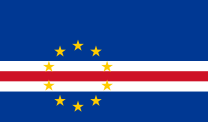Flag of Cape Verde


Flag ratio: 2:3
The national Flag of Cape Verde was adopted on September 22, 1992, replacing the flag adopted during Cape Verdean independence, fought for with Guinea-Bissau, another former Portuguese colony on mainland West Africa.
Description
The 10 stars on the flag represent the main islands of the nation (a chain of islands off the coast of West Africa). The blue represents the ocean and the sky. The band of white and red represents the road toward the construction of the nation, and the colours stand for peace (white) and effort (red). The yellow colour, circular formation of the stars, and dark blue field show similarity to the flag of the European Union. The stripes are in 6:1:1:1:3 ratio, and the circle of stars is centred 3/8 along the fly.
Proportions
The Constitution of the Republic[1] does not specify what the official proportions for the height and the width of the flag are. The dimensions of the parts that make up the flag are given proportionally to the dimensions of the sides, without specifying those dimensions. However, the proportion most widely used is 2:3[2], which is the same proportion that was used in the flag prior to 1992. Consequently, the proportion of 2:3 is the de facto (but not de jure) proportion.
Colour shades
The Constitution does not specify which are the official shades of the flag's colours. However, the most widely used colour shades are the primary colours of the RYB color model:
| Color |
Web colors |
RGB |
CMYK |
HSV |
| Blue |
#0000ff |
0, 0, 255 |
100%, 100%, 0%, 0% |
240, 100, 100% |
| White |
#ffffff |
255, 255, 255 |
0%, 0%, 0%, 0% |
0, 0, 100% |
| Red |
#ff0000 |
255, 0, 0 |
0%, 100%, 100%, 0% |
0, 100, 100% |
| Yellow |
#ffff00 |
255, 255, 0 |
0%, 0%, 100%, 0% |
60, 100, 100% |
Consequently, these colour shades are the de facto (but not de jure) colour shades.
History

Prior flag (1975-1992)
The original flag was introduced on independence in 1975, with the common African colours of red, green and yellow; it is identical to the flag of Guinea-Bissau except for the charge in the hoist-side stripe. Both flags are based on the PAIGC flag, and their similarity evoke the plans to unite both countries, which however were abandoned shortly after independence.
References
External links
|
Flags of Africa |
|
Sovereign
states |
Algeria · Angola · Benin · Botswana · Burkina Faso · Burundi · Cameroon · Cape Verde · Central African Republic · Chad · Comoros · Democratic Republic of the Congo · Republic of the Congo · Côte d'Ivoire (Ivory Coast) · Djibouti · Egypt · Equatorial Guinea · Eritrea · Ethiopia · Gabon · The Gambia · Ghana · Guinea · Guinea-Bissau · Kenya · Lesotho · Liberia · Libya · Madagascar · Malawi · Mali · Mauritania · Mauritius · Morocco · Mozambique · Namibia · Niger · Nigeria · Rwanda · São Tomé and Príncipe · Senegal · Seychelles · Sierra Leone · Somalia · South Africa · Sudan · Swaziland · Tanzania · Togo · Tunisia · Uganda · Zambia · Zimbabwe
|
|
States with limited
recognition |
Sahrawi Arab Democratic Republic · Somaliland
|
|
Dependencies,
autonomies,
other territories |
Canary Islands / Ceuta / Melilla / Plazas de soberanía (Spain) · Madeira (Portugal) · Mayotte / Réunion (France) · Puntland (Somalia) · Saint Helena, Ascension and Tristan da Cunha (United Kingdom) · Southern Sudan (Sudan) · Western Sahara · Zanzibar (Tanzania)
|
|
|
National flags and coats of arms |
|
| National flags |
Sovereign states · Dependent territories · States with limited recognition · Micronations · Stateless
|
|
| National coats of arms |
Sovereign states · Dependent territories · States with limited recognition · Micronations · Stateless
|
|

